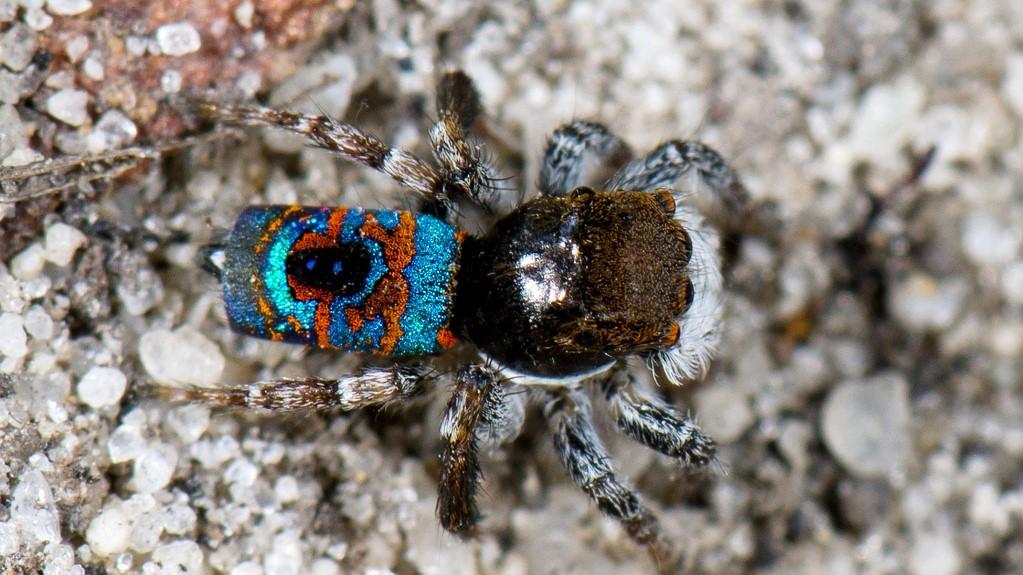Two arachnid experts share their four favorite spider facts
A peacock spider.
If you’re afraid of spiders, join the club: Catherine Scott and Eleanor Spicer Rice have been right there with you.
“I used to be terrified of spiders until I was about 25 years old and started studying them,” Scott says. These days, she’s an arachnologist and Ph.D. student at the University of Toronto. Rice, for her part, is now an entomologist with a book, “Dr. Eleanor’s Book of Common Spiders,” due out this winter.
So, what changed?
“For me, the process of turning fear to fascination was relatively [quick], and it was just all about spending time with spiders, watching their behavior, and learning more about them,” Scott says. “So I think the more you know, the more you understand spiders and the less reason you have to fear them.”
Together with entomologist Matt Bertone, Scott and Rice run a citizen science project, Recluse or Not?, which helps people identify the spiders they spot in their homes. “One thing that we’re learning is that most people think that every single spider that they see in their house is a brown recluse, whether it looks like one or not,” Rice says. And even if it is a brown recluse, Scott says, “there’s a reason they’re called recluse spiders, because they are reclusive,” she says. “They have no interest in you.”
In the spirit of getting to know spiders better — and even learning to love them — Rice and Scott shared some of their favorite arachnid facts.
1. Black widow spiders bite us only as a last resort
Scott points to one study in which scientists poked and prodded black widows, trying to get them to bite. The findings were conclusive: “they’re either going to run away because they’re much more afraid of us than we are of them, they’re going to play dead to try to get us to leave them alone, or they’ll fling sticky silk, which is their main defense,” she says.
“It was only when the researchers squeezed them between silicone fingers that the spiders ever bit,” she adds, “and even then, only about 60% of the time would the black widows bite — when they were being squeezed, and had no other recourse.” She adds that when the spiders did bite defensively, over half of those bites were dry, with no venom.
“So [black widows] can control whether or not they inject venom when they bite, and it turns out that venom is really expensive, metabolically, for spiders to produce, and it’s for subduing prey,” Scott says. “It’s not actually for defense, and it’s not very effective at defense. So they want to save up their venom for their next meal, and not waste it on biting.”
2. Lynx spiders are valuable farmhands
“Spiders aren’t going to be living in your house unless they have something to eat,” Rice says. “So they’re there doing something for you in your house, and they do the same thing in agricultural fields. They’ve found that if you take lynx spiders out of agricultural fields, the pest populations just skyrocket because they’re there eating all of these pests without pesticides. They do tons of wonderful things just from eating.”
3. Wolf spiders are caring parents
According to Scott, many spider species will give parental care — wolf spider mothers carry their babies around on their backs, for example. “And wolf spiders, for instance, or in the social velvet spiders, mothers will actually regurgitate food for their babies just like bird parents do for their offspring,” she adds. “So yeah, spiders take really good care of their babies.”
4. Spider mates communicate with each other using chemicals
“Every spider can eat every other spider because they’re predators,” Rice says. “So to keep each other from eating each other, they have developed some pretty crazy behaviors to tell each other that they’re mates.”
For example, Scott explains that black widows use “web-based personal ads” to find their mates.
“So the female black widow has a smell on her silk, on her web, that is an advertisement that provides males with information about her: Where she is, whether she’s mated before, and even whether or not she’s hungry, which — like Eleanor was saying — is really important,” she says. “If the female is hungry, she poses a threat to the male when he enters her web. He might become a meal rather than a mate. So yeah, spiders are great at using chemicals to communicate with one another, which most people probably don’t think about.”
Plus, have you ever seen a peacock spider?
“If you’ve never seen a peacock spider, please go and Google 'peacock spider' right now, because they’re the most beautiful animals in the world,” Scott says. “Their abdomen looks like a peacock’s tail that’s rainbow-colored. And you can’t not start to like spiders a little bit once you’ve seen a peacock spider.” (Check out this SciFri video of the peacock spider’s wild mating dance.)
This article is based on an interview that aired on PRI’s Science Friday with Ira Flatow.
We want to hear your feedback so we can keep improving our website, theworld.org. Please fill out this quick survey and let us know your thoughts (your answers will be anonymous). Thanks for your time!
